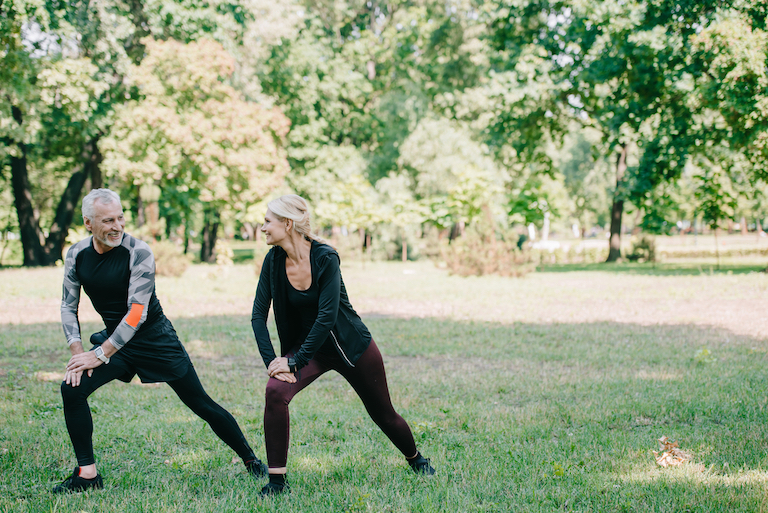Living with chronic pain can often make physical activity seem daunting and overwhelming. At Michigan Health and Wellness Center, we understand how pain can restrict your life, but it’s important to recognize that exercise is not just possible; it can be a transformative tool for managing your symptoms and enhancing your overall quality of life. So, you might be wondering, “How can I start exercising when I’m dealing with chronic pain?”
Understanding Chronic Pain and Exercise
Chronic pain, a pervasive ailment affecting millions globally, persists over long periods—often months to years—and can significantly impede daily activities and quality of life. This type of pain is not just a symptom but often a chronic condition in itself, fundamentally altering the nervous system.
Research supports physical activity as a crucial strategy in managing chronic pain. Engaging in regular, tailored exercise can deliver profound benefits:
- Pain Reduction: Exercise has been shown to diminish pain intensity. Activities that enhance muscle strength and joint stability can decrease the stress on painful areas, which is particularly beneficial in conditions like osteoarthritis.
- Improved Physical Function: By improving muscle strength and mobility, exercise enhances the body’s ability to perform daily activities more efficiently and with less discomfort.
- Endorphin Release: Physical activity promotes the release of endorphins, natural mood lifters, and pain suppressors, which can improve overall well-being.
- Mental Health Benefits: The psychological aspects of exercise are also significant; it can serve as a distraction from pain and boost mental health by improving mood and reducing symptoms of depression and anxiety.
Despite prevalent concerns, exercise does not exacerbate chronic pain when properly managed and customized to an individual’s capabilities and needs. On the contrary, it is a powerful means to alleviate it gradually. Therefore, developing a personalized exercise plan with healthcare professionals’ guidance is essential to ensure safety and effectiveness.
Preparing to Exercise
Before beginning any exercise routine, taking time to do a self-assessment to understand your current capabilities and limitations is essential. This self-evaluation should focus on identifying any pain points, understanding your body’s range of motion, and gauging your overall fitness level.
Following this, consulting with a functional medicine provider like Dr. Tony Aboudib can further refine your approach to exercise. With over 30 years of chiropractic experience and 15 years in functional medicine, Dr. Tony comprehensively understands how the body moves and functions. He can help evaluate external and internal factors that could be influencing your chronic pain and your ability to exercise effectively. This might include:
- Functional Assessment: Dr. Tony Aboudib can provide insights into how different systems of your body are interacting and any dysfunctions that might be contributing to your pain.
- Root Cause Analysis: Utilizing tools like the AO Scan, Dr. Tony can delve deep into the vibrational frequencies of your body’s cells and organs. This technology helps uncover the root causes of chronic pain, providing a detailed blueprint for personalized health interventions alongside exercise.
This approach prepares you for a physically active lifestyle and integrates holistic health practices to address all underlying factors of chronic pain. Combining self-evaluation with professional guidance allows you to embark on your exercise journey confidently and clearly understand what is best for your body.
Designing Your Exercise Plan
Creating an effective exercise plan when managing chronic pain requires a balanced approach that respects your body’s current state while encouraging gradual improvement. Here’s how you can design a plan that fosters recovery and resilience:
- Start With Low-Impact Exercises: Begin with activities that place minimal stress on the body. Walking, swimming, and stationary cycling are excellent for increasing heart rate without overburdening painful joints.
- Incorporate Flexibility Exercises: Flexibility training, such as gentle stretching and yoga, can improve joint range of motion and decrease stiffness. Start with light stretches, focusing on areas that support major joints like the hips, shoulders, and back.
- Build Strength Gradually: Strength training is crucial as it helps build muscle to support and protect joints. Begin with light resistance, using elastic bands or body-weight exercises, and slowly increase the intensity as your comfort level improves.
- Include Endurance Training: As your tolerance for activity increases, slowly incorporate endurance exercises into your routine. These activities help build stamina and can improve overall cardiovascular health. This could include something as simple as walking, where you begin to build up speed and length of exercise over time to build endurance.
- Customize to Your Needs: Adjust the intensity, duration, and type of exercises based on how your body responds. Listen to your body and modify your activities to ensure you do not exacerbate your pain.
- Regular Adjustments: As you progress, regularly evaluate the effectiveness of your plan with your healthcare provider and make necessary adjustments. This iterative process ensures that your exercise plan remains aligned with your health goals and adaptations.
- Don’t Give Up: We know that chronic pain can make exercise and other daily tasks feel nearly impossible. Remember that even little changes can have big impacts on your overall health and well-being.
This structured approach ensures that you manage your chronic pain through exercise and enhance your overall physical resilience, making daily activities more manageable and less painful.
Recommended Low-Impact Exercises

Engaging in low-impact exercises is crucial for managing chronic pain, as they minimize stress on the body while still providing the essential benefits of physical activity. Here are some tailored exercises that can help get you started:
- Walking: Often underrated, walking is an accessible form of exercise that can significantly improve cardiovascular health without putting excessive stress on the joints. Start with manageable, short distances and gradually increase as your endurance and comfort levels improve.
- Swimming and Water Aerobics: The buoyancy of water supports your body weight, reducing strain on painful joints and muscles. These activities enhance muscular strength and endurance, improve flexibility, and can be incredibly soothing for chronic pain conditions.
- Yoga and Tai Chi: Both practices incorporate gentle movements with deep breathing and mental focus, which can help reduce both physical pain and mental stress. They are effective in increasing flexibility, balance, and strength, making them ideal for those with chronic pain.
- Stretching: Incorporating regular stretching into your routine can greatly improve flexibility and reduce tension in areas that commonly experience pain. Focus on gentle stretches that do not cause pain, holding each position for a comfortable duration to ensure muscles are properly elongated.
Each of these exercises are designed to help you build up your movement over time, and if there is anything we hope you take away from this, you don’t need to go and do a HIIT workout every day to see the benefits of exercise – you can just walk. It really can be that simple!
Tips for Pain Management During Exercise
Managing pain during exercise is essential for ensuring that your activities are both beneficial and sustainable. One of the most important things you can do is listen to your body. If you experience pain that feels sharp or wrong, it’s crucial to stop and reassess; this type of pain is a signal that something isn’t right, and pushing through can lead to injury or worsened conditions.
Starting each exercise session with a gentle warm-up can significantly aid in preparing your body for physical activity. A warm-up gradually increases your heart rate and loosens your muscles, which can include activities like light stretching or a brisk walk. Similarly, cooling down after exercising helps to reduce your heart rate gradually and can prevent muscle stiffness, contributing to better recovery and less discomfort post-workout.
Pain-relief techniques such as ice or heat can also manage inflammation or soothe muscles after your workout. Techniques like foam rolling or gentle massage are beneficial for releasing tension in tight areas, enhancing your overall exercise experience, and preventing pain.
It’s also important to modify exercises to suit your comfort level. For instance, if running proves too strenuous on your joints, consider switching to lower-impact activities like walking or yoga. Consultation with a healthcare provider, such as a physical therapist, can provide personalized modifications that tailor exercises to your needs without exacerbating pain.
Ensure that any increase in the intensity or duration of your workouts is gradual. A sudden ramp-up in activity can lead to injury or increased pain, potentially setting back your progress. Keeping well-hydrated and ensuring sufficient rest are also vital components of an effective exercise regimen, as they support muscle recovery and overall pain management.
Integrating these mindful practices into your routine allows you to effectively manage your chronic pain during exercise, making your physical activity more enjoyable and impactful for your health.
Staying Motivated and Overcoming Setbacks
Starting on an exercise journey while managing chronic pain can be challenging, and staying motivated is key to long-term success. Recognize that setbacks are a normal part of the process, and overcoming them is not just possible but an important step in your journey toward better health.
Setting small, achievable goals can help maintain your motivation, and make sure to celebrate each milestone, no matter how minor. Keeping a journal to track your progress and reflect on what increases or alleviates your pain can also be a valuable tool for your healing process. This can provide valuable insights into the strategies that work best for you and help tailor your approach as you go.
Don’t hesitate to seek support from others. Whether it’s joining a support group, participating in community exercise programs, or simply sharing your goals with friends and family, having a support network can make your journey more enjoyable and less daunting.
Finally, remember why you started. Regular exercise can significantly improve mobility, reduce pain, and enhance your overall quality of life.
Each small step forward is progress, and with patience and persistence, these steps add up to substantial improvements.
Ready to redefine your relationship with exercise and chronic pain? Schedule a free consultation with Dr. Tony Aboudib at Michigan Health and Wellness Center today. Together, we can explore the root causes of your pain and tailor a plan that brings healing and hope back into your life. Let’s take that first step towards a more active and fulfilling life together.
Disclaimer: The information provided in our blog posts is for educational and informational purposes only and is not intended as medical advice. While we strive to share knowledge and insights on health-related topics, this content should not be used as a substitute for professional medical advice, diagnosis, or treatment. Always consult with a qualified healthcare professional regarding any medical concerns or decisions related to your health and well-being.

